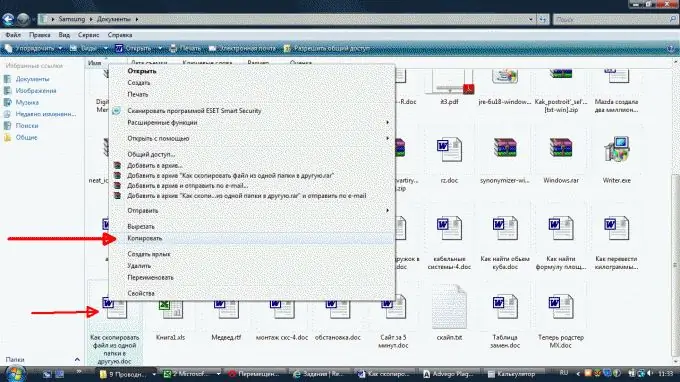When working on a computer, you often have to copy files from one folder to another. In most cases, this operation is not difficult even for novice users. However, with an inattentive attitude to this process, even an experienced "user" can lose important information.

Necessary
computer
Instructions
Step 1
To copy files from one folder to another, place these folders next to each other. Then move your mouse to the file in the original folder. Press and hold the left mouse button and the Ctrl button on the computer. Drag the copied file to the target folder, release the mouse and keyboard buttons. Check whether the copied file appears in the target folder - for this you may have to execute the "Update" command called from the context menu (by pressing the right mouse button).
Step 2
If it is problematic to place both folders on the desktop at the same time, or if the above method does not work, then use an alternative method. To do this, point the mouse cursor to the copied file, press the right mouse button and select the "Copy" context (drop-down) menu item. Then open the target folder, place the mouse cursor on any empty spot of this folder and execute the context command "Paste". Check for the copied file in the target folder. When copying files in this way, make sure that the mouse cursor points exactly to an empty space in the target folder. Otherwise, the copied file may end up in a subdirectory of the target folder or try to "append" to someone else's archive.
Step 3
Note that the Copy command does not physically copy the contents of the file. In reality, information starts to be copied only when the "Paste" command is executed. Therefore, do not delete or disconnect removable media (flash drives, CDs and DVDs, etc.) until the desired file is in the target folder.
Step 4
If the information to be copied is very important, then duplicate the copying process on several different media. If this is not possible, then create an additional (sub) folder on the flash drive (disk, floppy disk) and copy the file there again. If possible, check if the copied file is being opened and skim through its contents. It is advisable to check the quality of the file recording not on the device on which the recording was made, but on a similar one. This is especially true for floppy disks, since an FDD drive usually reads floppy disks written on it well, but refuses to read "foreign" ones.
Step 5
When copying files, copy the files, not their shortcuts (which outwardly often differ from files only by the presence of an arrow in the lower left corner). Do not allow the common mistake of novice users who, having collected all the shortcuts from the desktop on a flash drive, believe that they have copied all the information from the computer.






